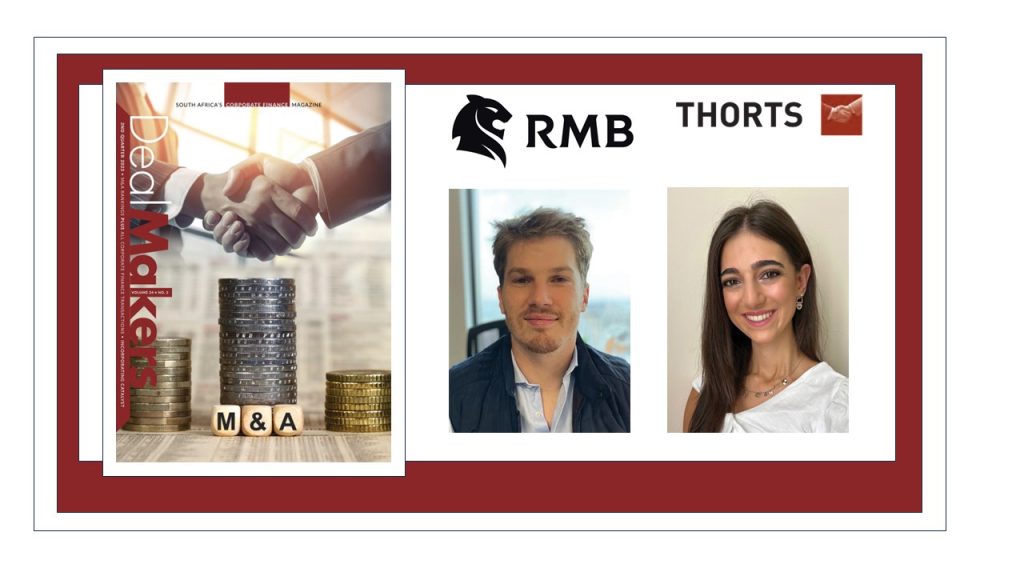The macro landscape in South Africa is challenged by muted growth, constrained energy availability, rising interest rates and disrupted rail logistics, just to name a few.
While all local companies are affected in one way or another, the industrial sector is particularly exposed, as evidenced by the fact that the JSE FTSE All Share Index has, in aggregate, increased around 33% over the last five years, while a market-weighted average of 44 JSE-listed industrial stocks decreased by approximately 10% over the same period.
This backdrop has translated into significantly lower M&A activity in South Africa. According to DealMakers, there have only been 32 M&A transactions concluded in the first quarter of 2023, compared to 82 transactions in Q1 2022. At this rate, it is almost certain that 2023 will fall short of the 731 deals concluded in 2022, although the RMB Corporate Finance house view is that deal activity is likely to pick up later in this calendar year.
Industrial counters are bearing the brunt of the current economic climate and, looking at valuation levels in the sector, it suggests a buyers’ market. We believe that there are good acquisition opportunities in the sector for those who are willing (and brave enough) to search for them through a ‘value-orientated lens’. Looking at a basket of 44 industrial stocks listed on the JSE, the average PE multiple over the last year is approximately 9x compared to the 10-year average (excluding COVID-19) of approximately 13.5x.
We looked at the work of well-known global value investors to identify some of the key principles that they use in their investment approaches and how they could be applicable in a South African acquisition context.
- Understand the importance of market cycles
“The pendulum of investment psychology is constantly fluctuating between optimism and pessimism, between greed and fear, between credulousness and skepticism, between risk tolerance and risk aversion.” – Howard Marks, co-founder and co-chairman of Oaktree Capital Management.
Just about everything in the financial world is cyclical – from market liquidity to interest rates to the financial performance in the SA industrial sector. The most basic reason for this is human nature. Undoubtedly, there are also objective drivers that play a part in cycles, such as the COVID-19 pandemic (which, in financial market terms, led to a massive dip and almost as big a jump in very short order), but it is the application of psychology to these drivers that determines the amplitude of cyclical fluctuations.
It feels as though we are in a period where the weak SA economy, together with several objectively negative events, is leading to an abundance of (often exacerbated) bearish news flow. This is driving risk aversion, which in turn creates behaviour from investors and capital allocators that is driving valuations down. Eventually, a point will come where these valuations become attractive enough for the underlying prospects being valued that the contrarians will start knocking at the door and, in time, other capital allocators will follow suit. This behaviour is the catalyst that ultimately leads to an upturn in the cycle, and value-focused capital allocators worth their stripes can identify a cycle and leverage off it.
- Behave in a counter-cyclical and contrarian manner
“To buy when others are despondently selling, and to sell when others are euphorically buying takes the greatest courage, but provides the greatest profit.” – Sir John Templeton, founder of the Templeton Growth Fund.
Many investors tend to be trend followers, which is what creates market cycles. Highly successful capital allocators are the opposite. As the cycle corrects itself, a big part of effective capital allocation lies in buying companies when everyone is against them and their prospects, and selling companies when everyone loves them. Of course, this is a difficult and scary thing to do, but it can be very rewarding when done right.
We had a conversation with the CEO of a well-known manufacturing company, who told us how one of their main global competitors went from half its size to almost double its size in less than seven years, and how a substantial part of the growth resulted from two large acquisitions when the market was close to its lowest level.
If you consider the recent acquisitions in the South African cement industry (Afrimat acquiring Lafarge South Africa and Huaxin Cement acquiring Natal Portland Cement), one could argue that these were contrarian moves, where the rest of the market was seeing limited growth in the short term.
- Buy at an acceptable margin of safety
“Confronted with the challenge to distil the secret of sound investment into three words, we venture the motto – ‘Margin of safety.’” – Benjamin Graham, renowned value investor, lecturer, financial securities researcher, and mentor to Warren Buffet.
Margin of safety is effectively value investing’s credo – buying something for less than it’s worth. One can achieve a margin of safety when a company or stock is bought at a price sufficiently below its intrinsic value, allowing for human error, bad luck, or extreme volatility in a complex, unpredictable and rapidly changing world. This largely describes the South African industrial sector at present, characterised by potentially undervalued businesses, presenting an opportunity to buy at an acceptable margin of safety.
Looking at Afrimat’s acquisition of Lafarge South Africa at an enterprise value of approximately R800m, Chronux Research calculates that Afrimat is effectively acquiring Lafarge South Africa’s materials businesses at a 3x EV/EBITDA multiple and getting the cement business for free. Afrimat is known for acquiring good assets that need a little bit of work at a low price, having done something similar with Diro Iron Ore (now Demaneng Resources) a couple of years ago, and it shows with its market cap having increased around approximately 215% since July 2016 to R9,1bn.
- Search for quality and avoid too much leverage
“Using leverage is like playing Russian roulette – it means that you are inevitably going to get a bullet in the head.” – Ray Dalio, founder of Bridgewater Associates.
An important part of being able to take advantage of contrarian opportunities, even if acquired at a low multiple, is to ensure that the company has the runway to withstand stress. Even though one may be acquiring a business, believing in the long-term industry and company prospects, change often takes a long time. One needs to ensure that the business can keep the lights on, especially if things get worse. From an acquisition perspective, this entails two key points: i) buying high-quality businesses that are in strong fundamental positions and ii) not
over-leveraging them.
Reunert is a very good example of this. The company’s market capitalisation has been mostly stable over the last five years, but came under pressure in mid-2022, dropping to R5,8bn. Notwith-standing this, Reunert continued to operate its solid portfolio of assets efficiently, and continued making strategic acquisitions in line with its long-term strategy. Most recently, it has acquired defence component manufacturer, Etion Create, and technology-focused consulting agency, IQbusiness, without materially leveraging its balance sheet. Its market capitalisation has since strengthened to R9,3bn.
- Think long-term expected value
“The single greatest edge an investor can have is a long-term orientation.” – Seth Klarman, founder and CEO of the Baupost Group.
Often, when allocating capital, companies are too focused on the next year’s earnings. Acquisitions should be made that will maximise expected value, even if that means the lowering of near-term earnings. We frequently see too much emphasis being placed on the near-term EPS accretion or dilution when companies are considering acquisitions. This then deters companies from taking a long-term perspective and making contrarian plays when times are challenging.
These principles may seem simple, but it is often said that (value) investing is simple, not easy – implying that human nature often intervenes to the detriment of investing (or in the case of M&A, acquisition) success.
When it comes to industrial companies, while we have a firm belief in the longer-term prospects of the sector, we expect deal flow in the short term to remain muted, given concerns around ‘forecast error’ because of all the macro challenges. The implementation of transactions is also taking longer to conclude; in many instances, due to longer and more difficult negotiations on risk and reward, including valuations and warranties, allied with longer regulatory approval processes.
As a result, we think that there will be fewer, but better, long-term acquisitions made, as buyers seek to identify opportunities that tick boxes along the lines of the five principles covered above. Deal flow is likely to be driven by:
• Consolidation and bolt-on acquisitions: we continue to see consolidation as bigger companies with stronger balance sheets look to integrate the value chain to manage costs and enhance margins and cash flows;
• Delisting transactions: there have been many delistings off the JSE in the past couple of years, and it has been particularly busy in the industrial sector (Imperial, Value Logistics, Onelogix, Afrox and Rolfes Holdings, to name a few). We see this trend continuing, given the ‘value trap’ that we’re seeing in the small and mid-cap industrials sector; and
• International M&A: large multinational industrial companies looking to strategically expand into the African continent often see South Africa as the launch pad for such a regional expansion, and we see a surprising amount of inbound interest as a result. The logistics sector is currently particularly active in this regard, with Taylor Maritime Investments’ acquisition of Grindrod Shipping and AP Moller Capital’s acquisition of Vector Logistics as prime examples. There are also South African operators looking to expand into broader Africa and offshore to diversify regional exposure and look at growth opportunities, like Omnia, which recently established a joint venture between its mining focused subsidiary, BME, and PT Multi Nitrotama Kimia, an Indonesian explosives and blasting services provider. In our view, these cross-border deals are expected to continue.
Alex Volschenk is a Lead Banker in the Automotive, Logistics and Industrials Sector and Cara Pardini a Corporate Finance Transactor | RMB.

This article first appeared in DealMakers, SA’s quarterly M&A publication.
DealMakers is SA’s M&A publication.
www.dealmakerssouthafrica.com



